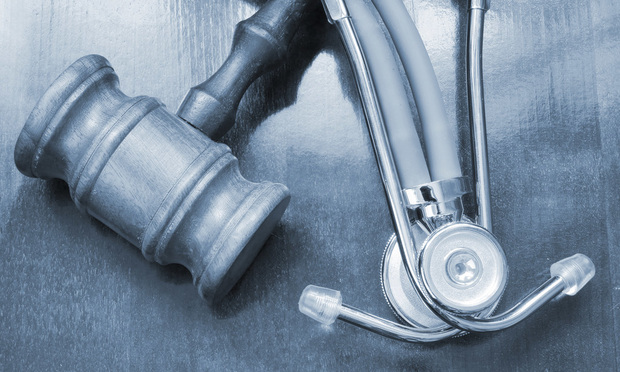 As federal judges in New York andelsewhere continue to hand down decades-plus long prison sentences for health care fraud and the administrationincreases federal resources devoted to combating health care fraud,health care providers should pay closeattention to the “badges of fraud” that may land a companyin the crosshairs of a federal criminal investigation.
As federal judges in New York andelsewhere continue to hand down decades-plus long prison sentences for health care fraud and the administrationincreases federal resources devoted to combating health care fraud,health care providers should pay closeattention to the “badges of fraud” that may land a companyin the crosshairs of a federal criminal investigation.
Below, we look at the “red flags”—the areas of potential fraudof which a health care company should be aware to stay compliantand off the DOJ's radar.
|A hot enforcement area
It should come as no surprise to health care professionals thatcriminal health care fraud enforcement is increasing. The highlysuccessful U.S. Department of Justice Medicare Fraud Strike Force,led by the Fraud Section in Main Justice, has convicted thousandsof defendants nationwide, and its last health care fraud “takedown”in July 2017 was the biggest in DOJ history with more than 400individuals charged. Judges continue to impose lengthy prisonsentences, including a 13-year sentence handed down to Dr. ImranAhmed in February 2018 in the Eastern District of New York.
|Related: Death, fraud and ACA subsidies
|These stats are only poised to increase as the administrationhas devoted significant federal dollars to combating health carefraud. The administration's fiscal year 2019 budget request callsfor $770 million in anti-fraud funding, a jump from the FY 2018request of $751 million.
|The bottom line: DOJ continues to view criminal health carefraud as a target-rich environment for investigation andprosecution.
|What are the top red flags for health care fraud?
As a health care industry GC or executive, you should be on thelookout for any of these red flags in your business practices.
|(1) Opioids. Not surprisingly, if you or yourcompany prescribes, sells or distributes opioids, thatmere fact alone could warrant scrutiny, given the administration'sfocus on combating the opioid epidemic. In August 2017, AttorneyGeneral Sessions announced the formation of the Opioid Fraud andAbuse Detection Unit, a pilot program that uses data to identifyand prosecute individuals engaged in opioid-related health carefraud. The program will fund 12 Assistant U.S. Attorneys, to belocated in health care fraud hot spots around the country. TheseAUSAs will focus on investigating and prosecuting “pill mills,”pharmacies that improperly divert and dispense prescriptionopioids, and other opioid-related issues. Overall, if your practicewrites a high number of prescriptions for opioids, that fact alonecould spark enforcement interest.
|(2) Home health care. Home health care fraudhas traditionally been a rich area of prosecution for DOJ.Generally speaking, home health care can be prescribed by a doctorwhen the patient is homebound and needs intermittent skilled care.Traditional flavors of fraud in the home health care sphere haveincluded doctors writing prescriptions for home health care whenthere is no real medical necessity, unlicensed workers renderingthe “care,” workers billing for services not rendered (“no-showworkers”) and kickbacks being paid to recruit patients. If yourmedical practice includes home health care, be aware that yourpractices may fall under scrutiny. A recent example of a lengthyprison sentence handed down in this area is the 35-year sentencefor Dr. Jacques Roy in Dallas for home health care fraud involvingmore than 11,000 patients.
|(3) More data, more problems. For many years,DOJ has used providers' claims data to help identify health carefraud. This data crunching will continue to become moresophisticated over time as more resources are allocated to healthcare fraud data analytics. Uses of the data range from identifyinggeographic hotbeds for fraud so enforcement resources can betargeted and deployed to identifying the top doctors who are usingbilling codes that are suspected to be fraudulent. In this case,being the top biller in the country for a specific code is not agood thing and will almost certainly lead to greater scrutiny.
|DOJ will zero in on these outliers as a possible badge of fraud,looking for a disconnect between the size of the medical practiceand the volume of billing (i.e., a small practice with a largevolume of billing), incongruity between the practice's specialtyand the types of codes billed (e.g., a general practitionerprescribing a high percentage of opioids), and whether a largeportion of the overall claims billed skew toward higher-payingcodes even when lower-paying codes are available. The bottom line:Know your data and be able to defend it. If you are a high-volumebiller, or if there are anomalies or spikes, you could betargeted.
|(4) Robosigning. A common theme amongmany health care fraud cases is the practice known as“robosigning,” which typically involves a doctor blindly writingprescriptions or orders that authorize care without first making anindividualized determination of medical necessity.
|The government will use data analytics and other means toidentify possible robosigning, especially when the orders are forexpensive drugs or services, or those areas of care that have atrack record of inappropriate ordering (such as opioids, homehealth care, power wheelchairs and sleep studies). Your companyshould ensure that the authorizing medical professional is actuallymaking a case-by-case analysis of medical necessity before orderingdrugs or services. And importantly, the company should be able tore-create and affirmatively prove this process was actuallyused.
|(5) Kickbacks. The payment ofkickbacks or other illicit benefits to patients, recruiters whoprocure such patients, or even to doctors or other medicalprofessionals, continues to be a major problem. Where appropriate,clinics should actively question management as to how the patientslearned of the clinic or why the patient selected your clinic overothers.
|Internal data will show if the patient is a “frequent flier” inan office and whether the patient has presented with a number ofdifferent ailments over time that seem implausible or has receivedtreatment at your facility for which they inexplicably re-presentmultiple times. This could be suggestive of a patient who is beingpaid to visit your facility. If one patient is being paid, it islikely there are more. Criminal penalties for paying and receivingkickbacks are severe, and any suggestion that this is occurringshould be investigated immediately.
|(6) Upcoding. Upcoding refers to theimproper practice of a medical professional billing for a moreexpensive medical service than was actually provided to thepatient. While upcoding can occur in a myriad of ways, DOJ oftenfocuses on service-based, location-based or time-based upcoding. Inservice-based upcoding, a doctor may perform a simple check-up, butbill for a more extensive examination or even a surgery.
|A location-based example could be billing for a procedure thatoccurred in an operating room when, in fact, it had occurred in aless-expensive setting such as an office. Finally, time-basedupcoding fraud can occur when a doctor sees a patient for 10minutes, but bills for a more expensive 45-minute consultation.These upcoding schemes are more difficult for law enforcement tounravel, but the claims data will give rise to greater potentialscrutiny when providers consistently use higher-paying codes.
|(7) Billing for unqualifiedworkers. Another common theme in health carefraud cases is billing for unqualified or unlicensed workers. Onthe obvious side, many cases have featured clinics using a lessqualified worker (such as a physician's assistant) to renderservices to a patient, but the services are billed as if they wereprovided by a medical professional with a higher reimbursementrate.
|Other subtler variations on this theme are clinics that bill forlower-level medical professionals (such as physical therapyassistants) who are supposed to be supervised by a higher-levelmedical professional (a physical therapist) but operate withoutsupervision. Your facility must have the proper monitoringequipment (e.g., electronic badging, timecards, etc.) to be able todemonstrate which medical professional actually saw the patient andin the case of supervision requirements, who was on-site whencertain care requiring supervision was rendered.
|Conclusion
The administration has backed up its tough talk on combatinghealth care fraud with new initiatives and more money. Make nomistake—federal enforcement of criminal health care laws standspoised to become increasingly muscular and robust. Knowing the redflags the federal authorities will look for will help your companybe more compliant and mitigate the risk of becoming the subject ofa federal criminal health care fraud investigation.
Maranda E. Fritz is a partner inThompson Hine's New York office, Sarah M. Hall is senior counsel inthe firm's Washington, D.C. office, and John R. Mitchell is apartner in the firm's Cleveland office. Hall is a former federalprosecutor, and Fritz and Mitchell are former state prosecutors.All three authors are members of the firm's white-collar criminalpractice, internal investigations and government enforcementpractice.
Complete your profile to continue reading and get FREE access to BenefitsPRO, part of your ALM digital membership.
Your access to unlimited BenefitsPRO content isn’t changing.
Once you are an ALM digital member, you’ll receive:
- Critical BenefitsPRO information including cutting edge post-reform success strategies, access to educational webcasts and videos, resources from industry leaders, and informative Newsletters.
- Exclusive discounts on ALM, BenefitsPRO magazine and BenefitsPRO.com events
- Access to other award-winning ALM websites including ThinkAdvisor.com and Law.com
Already have an account? Sign In
© 2024 ALM Global, LLC, All Rights Reserved. Request academic re-use from www.copyright.com. All other uses, submit a request to [email protected]. For more information visit Asset & Logo Licensing.







